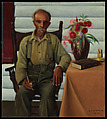Uncle Bob
Archibald J. Motley, Jr. American
Uncle Bob is the first work by Archibald J. Motley, Jr. to enter The Met’s collection. A key painter in the flourishing of Black American art, literature, and culture of the 1920s and 1930s known as the Harlem Renaissance, Motley remains most widely known for scenes of everyday life in the Bronzeville area of Chicago, where he lived and worked, though portraiture was an important part of his practice. He painted several family members—usually elders—throughout his career. His sitter in this instance is his mother’s half-brother, Robert (Bob) White, who was born enslaved in 1850 but eventually owned his own farm. Motley portrays him at home in Arkansas seated on his porch, wizened by age after decades of labor. The table next to him features a still life arrangement of a vase of flowers, an ashtray complete with match holder, and a book, perhaps a Bible, a detail that might signify White’s literacy.
Meeting the viewer’s gaze, the sitter holds a pipe in his right hand, which rests on his knee. His left elbow rests on the table, allowing his other arm and hand to extend toward the viewer. The artist has paid particular attention to the sitter’s large, powerful hands, perhaps enhancing their relative scale in homage to his subject’s life of hard labor and perseverance. The regular pattern of clapboard house siding in the background reinforces his implied strength, while the nearby ebullient floral bouquet serves as a foil to his affectingly plain expression.
Informed by and responsive to contemporary discourses regarding modern Black identity and racial uplift, particularly those concerning the important concept of "The New Negro"—as promoted by Alain Locke and debated by a range of intellectual luminaries such as W.E.B. DuBois—Motley conceived of his portrait painting as a means of countering and negating the demeaning, dehumanizing stereotyped images of Black Americans that historically served to justify personal and systemic racism in the United States. In this regard, the artist’s tender, nuanced, and reverential portrayal of Uncle Bob begins to register as a powerful rejoinder to historical but still prevalent tropes of Black servitude in popular visual and literary culture, such as Uncle Remus and Uncle Tom. As Locke wrote in his transformational compendium of essays, The New Negro (1925), "Uncle Tom and Sambo have passed on … [I]t is time to scrap the fictions, garret the bogeys and settle down to realistic facing of facts."
Motley received a Guggenheim Fellowship award in Fine Arts-Painting for Uncle Bob in 1929, a benchmark of the artist’s ascendant renown in the late 1920s.
This image cannot be enlarged, viewed at full screen, or downloaded.

